二语词汇知识对词汇推理及其策略选择.docx
- 格式:docx
- 大小:15.99 KB
- 文档页数:2
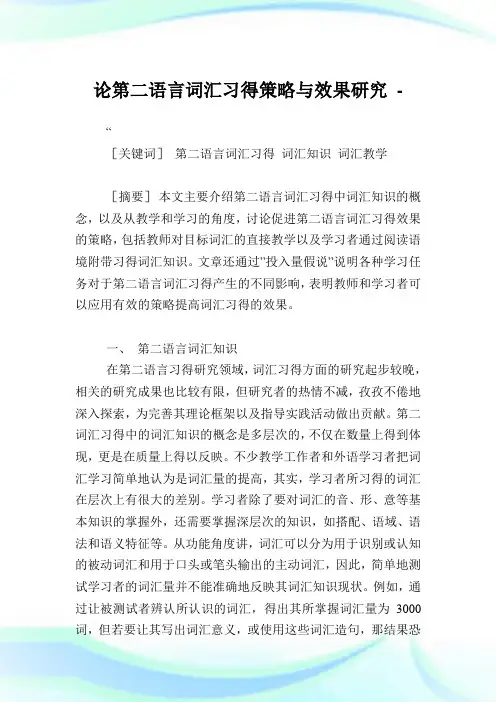
论第二语言词汇习得策略与效果研究-“[关键词]第二语言词汇习得词汇知识词汇教学[摘要]本文主要介绍第二语言词汇习得中词汇知识的概念,以及从教学和学习的角度,讨论促进第二语言词汇习得效果的策略,包括教师对目标词汇的直接教学以及学习者通过阅读语境附带习得词汇知识。
文章还通过”投入量假说”说明各种学习任务对于第二语言词汇习得产生的不同影响,表明教师和学习者可以应用有效的策略提高词汇习得的效果。
一、第二语言词汇知识在第二语言习得研究领域,词汇习得方面的研究起步较晚,相关的研究成果也比较有限,但研究者的热情不减,孜孜不倦地深入探索,为完善其理论框架以及指导实践活动做出贡献。
第二词汇习得中的词汇知识的概念是多层次的,不仅在数量上得到体现,更是在质量上得以反映。
不少教学工作者和外语学习者把词汇学习简单地认为是词汇量的提高,其实,学习者所习得的词汇在层次上有很大的差别。
学习者除了要对词汇的音、形、意等基本知识的掌握外,还需要掌握深层次的知识,如搭配、语域、语法和语义特征等。
从功能角度讲,词汇可以分为用于识别或认知的被动词汇和用于口头或笔头输出的主动词汇,因此,简单地测试学习者的词汇量并不能准确地反映其词汇知识现状。
例如,通过让被测试者辨认所认识的词汇,得出其所掌握词汇量为3000词,但若要让其写出词汇意义,或使用这些词汇造句,那结果恐怕要大打折扣了。
词汇知识中的主动词汇和被动词汇并没有明确的界限,也就是说,两者之间可以转换,或者更准确地说是有连续性的。
语言学家Henriksen(1999∶303)认为词汇习得的过程是一个连续体,是一个从被动/接受性知识向主动/输出性知识转化、或者从能理解词到激化词以用于使用的连续过程。
另外,Melka’s(1997∶99)认为接受性词汇与输出性词汇之间的距离在于对词的熟悉程度,而从接受性词汇这端转移到输出性词汇那端几乎无法被觉察到,因此是个连续性的过程。
对于大多数第二语言学习者来说,加强第二语言词汇知识比单纯地增加词汇量更为重要,而教师有效的词汇教学方法可以帮助学习者提高第二语言词汇习得的效果。
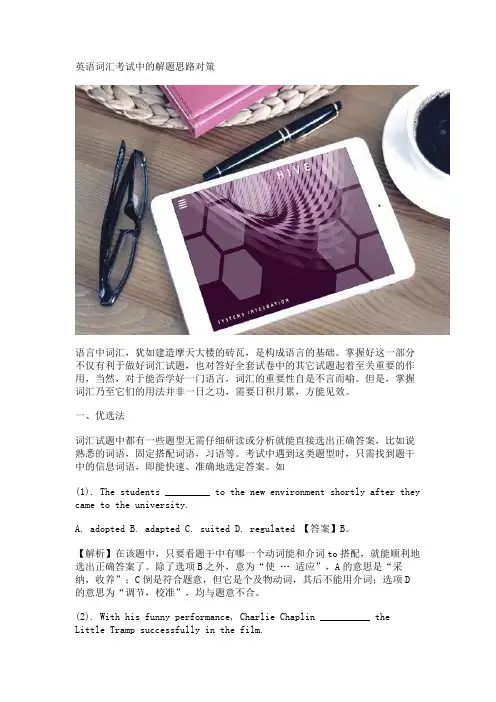
英语词汇考试中的解题思路对策语言中词汇,犹如建造摩天大楼的砖瓦,是构成语言的基础。
掌握好这一部分不仅有利于做好词汇试题,也对答好全套试卷中的其它试题起着至关重要的作用,当然,对于能否学好一门语言,词汇的重要性自是不言而喻。
但是,掌握词汇乃至它们的用法并非一日之功,需要日积月累,方能见效。
一、优选法词汇试题中都有一些题型无需仔细研读或分析就能直接选出正确答案,比如说熟悉的词语,固定搭配词语,习语等。
考试中遇到这类题型时,只需找到题干中的信息词语,即能快速、准确地选定答案。
如(1). The students _________ to the new environment shortly after they came to the university.A. adoptedB. adaptedC. suitedD. regulated 【答案】B。
【解析】在该题中,只要看题干中有哪一个动词能和介词to搭配,就能顺利地选出正确答案了。
除了选项B之外,意为“使… 适应”,A的意思是“采纳,收养”;C倒是符合题意,但它是个及物动词,其后不能用介词;选项D的意思为“调节,校准”,均与题意不合。
(2). With his funny performance, Charlie Chaplin __________ theLittle Tramp successfully in the film.A. discoveredB. inventedC. madeD. created 【答案】D。
【解析】这四个选项意思较为接近,但属于一种习惯表达法。
(3). Facing the present economic depression, he kept worrying about the future, not knowing what was to __________him.A. become ofB. become toC. become withD. happen 【答案】A。
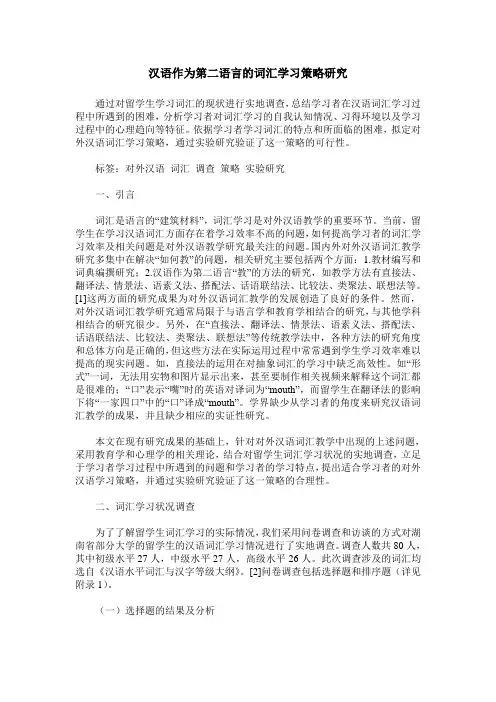
汉语作为第二语言的词汇学习策略研究通过对留学生学习词汇的现状进行实地调查,总结学习者在汉语词汇学习过程中所遇到的困难,分析学习者对词汇学习的自我认知情况、习得环境以及学习过程中的心理趋向等特征。
依据学习者学习词汇的特点和所面临的困难,拟定对外汉语词汇学习策略,通过实验研究验证了这一策略的可行性。
标签:对外汉语词汇调查策略实验研究一、引言词汇是语言的“建筑材料”,词汇学习是对外汉语教学的重要环节。
当前,留学生在学习汉语词汇方面存在着学习效率不高的问题,如何提高学习者的词汇学习效率及相关问题是对外汉语教学研究最关注的问题。
国内外对外汉语词汇教学研究多集中在解决“如何教”的问题,相关研究主要包括两个方面:1.教材编写和词典编撰研究;2.汉语作为第二语言“教”的方法的研究,如教学方法有直接法、翻译法、情景法、语素义法、搭配法、话语联结法、比较法、类聚法、联想法等。
[1]这两方面的研究成果为对外汉语词汇教学的发展创造了良好的条件。
然而,对外汉语词汇教学研究通常局限于与语言学和教育学相结合的研究,与其他学科相结合的研究很少。
另外,在“直接法、翻译法、情景法、语素义法、搭配法、话语联结法、比较法、类聚法、联想法”等传统教学法中,各种方法的研究角度和总体方向是正确的,但这些方法在实际运用过程中常常遇到学生学习效率难以提高的现实问题。
如,直接法的运用在对抽象词汇的学习中缺乏高效性。
如“形式”一词,无法用实物和图片显示出来,甚至要制作相关视频来解释这个词汇都是很难的;“口”表示“嘴”时的英语对译词为“mouth”,而留学生在翻译法的影响下将“一家四口”中的“口”译成“mouth”。
学界缺少从学习者的角度来研究汉语词汇教学的成果,并且缺少相应的实证性研究。
本文在现有研究成果的基础上,针对对外汉语词汇教学中出现的上述问题,采用教育学和心理学的相关理论,结合对留学生词汇学习状况的实地调查,立足于学习者学习过程中所遇到的问题和学习者的学习特点,提出适合学习者的对外汉语学习策略,并通过实验研究验证了这一策略的合理性。
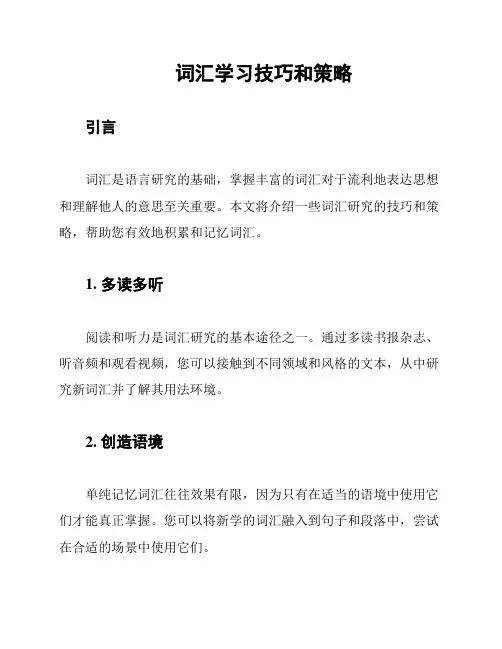
词汇学习技巧和策略引言词汇是语言研究的基础,掌握丰富的词汇对于流利地表达思想和理解他人的意思至关重要。
本文将介绍一些词汇研究的技巧和策略,帮助您有效地积累和记忆词汇。
1. 多读多听阅读和听力是词汇研究的基本途径之一。
通过多读书报杂志、听音频和观看视频,您可以接触到不同领域和风格的文本,从中研究新词汇并了解其用法环境。
2. 创造语境单纯记忆词汇往往效果有限,因为只有在适当的语境中使用它们才能真正掌握。
您可以将新学的词汇融入到句子和段落中,尝试在合适的场景中使用它们。
3. 制定研究计划为了高效地研究和记忆词汇,制定一个合理的研究计划很重要。
您可以设置每天或每周研究的时间段,将研究任务划分为小目标,并在研究过程中定期复已掌握的词汇。
4. 使用记忆技巧记忆技巧是词汇研究中的有力工具。
尝试使用联想、联结和故事等记忆技巧来帮助您记忆新词汇。
另外,使用词根、词缀和词源的知识,可以帮助您理解和记忆相关词汇。
5. 制作词汇卡片制作词汇卡片是一种常用且有效的记忆方法。
将生词和其对应的释义、例句写在卡片的一侧,将其反面留白,用于自测记忆。
您可以携带这些卡片随时进行复,加深对词汇的记忆。
6. 扩展词汇网络词汇是相互关联的,通过扩展词汇网络可以更好地理解和运用新学的词汇。
在研究新词汇时,注意寻找其同义词、反义词和相关词汇,拓展您的词汇视野。
总结词汇学习是学习语言的关键步骤之一。
通过多读多听、创造语境、制定学习计划、使用记忆技巧、制作词汇卡片和扩展词汇网络等技巧和策略,您可以更有效地学习和记忆词汇。
不断坚持并灵活运用这些方法,将会帮助您在语言学习的旅程中取得更好的成果。
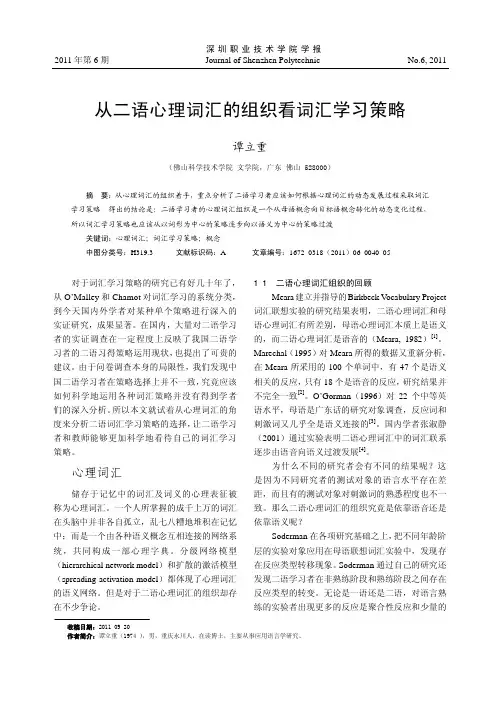
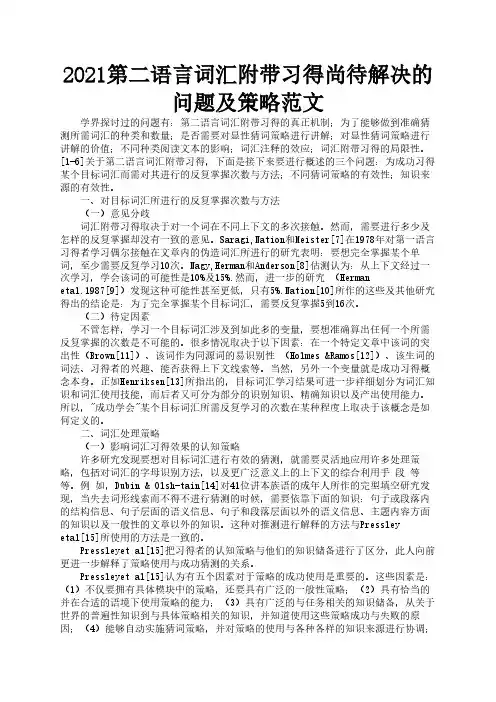
2021第二语言词汇附带习得尚待解决的问题及策略范文 学界探讨过的问题有:第二语言词汇附带习得的真正机制;为了能够做到准确猜测所需词汇的种类和数量;是否需要对显性猜词策略进行讲解;对显性猜词策略进行讲解的价值;不同种类阅读文本的影响;词汇注释的效应;词汇附带习得的局限性。
[1-6]关于第二语言词汇附带习得,下面是接下来要进行概述的三个问题:为成功习得某个目标词汇而需对其进行的反复掌握次数与方法;不同猜词策略的有效性;知识来源的有效性。
一、对目标词汇所进行的反复掌握次数与方法 (一)意见分歧 词汇附带习得取决于对一个词在不同上下文的多次接触。
然而,需要进行多少及怎样的反复掌握却没有一致的意见。
Saragi,Nation和Meister[7]在1978年对第一语言习得者学习偶尔接触在文章内的伪造词汇所进行的研究表明:要想完全掌握某个单词,至少需要反复学习10次。
Nagy,Herman和Anderson[8]估测认为:从上下文经过一次学习,学会该词的可能性是10%及15%.然而,进一步的研究(Hermanetal.1987[9])发现这种可能性甚至更低,只有5%.Nation[10]所作的这些及其他研究得出的结论是:为了完全掌握某个目标词汇,需要反复掌握5到16次。
(二)待定因素 不管怎样,学习一个目标词汇涉及到如此多的变量,要想准确算出任何一个所需反复掌握的次数是不可能的。
很多情况取决于以下因素:在一个特定文章中该词的突出性(Brown[11])、该词作为同源词的易识别性(Holmes &Ramos[12])、该生词的词法、习得者的兴趣、能否获得上下文线索等。
当然,另外一个变量就是成功习得概念本身。
正如Henriksen[13]所指出的,目标词汇学习结果可进一步祥细划分为词汇知识和词汇使用技能,而后者又可分为部分的识别知识、精确知识以及产出使用能力。
所以,"成功学会"某个目标词汇所需反复学习的次数在某种程度上取决于该概念是如何定义的。
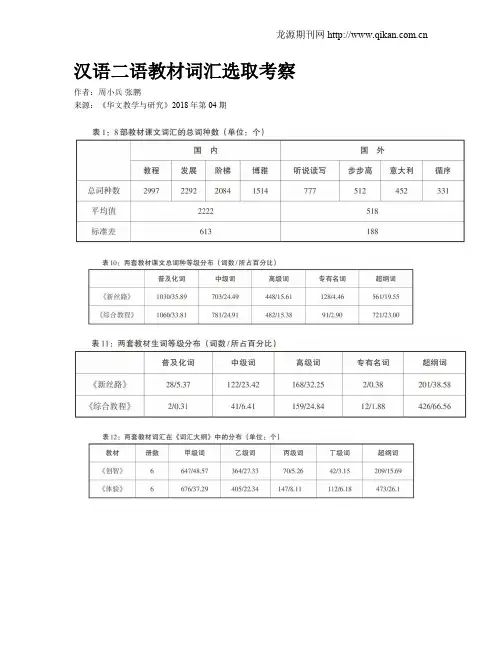
汉语二语教材词汇选取考察作者:周小兵张鹏来源:《华文教学与研究》2018年第04期[关键词]二语教材;词汇选取;难度等级;本土性[摘要]词汇选取是二语教材的重要内容。
以往研究教材词汇选取有两点不足:不够全面系统;缺少定量研究。
本文结合定性研究和定量研究,从以下6个维度对汉语教材的词汇选取进行系统考察:词语的地位与位置;词语数量;词语难度;母语者使用频率;词语本土性;文化词语。
考察发现,不同编写者的汉语教材,国内国外同级同类教材,不同合作者的海外用教材,在上述各个维度都有明显差异;并对差异进行了合理解释。
[中图分类号]H195.4 [文献标识码]A [文章编号]1674-8174 (2018) 04-0025-11谈到第二语言教材的词汇研究,教师首先想到可能是以下问题:生词是怎样选出来的?生词的量和难度如何确定?它跟课文话题有什么关系?怎样解释效果好?举什么样的例句、多少例句比较合适?生词呈现的上下文和语境应该怎么样?生词的重现率多少比较好?词汇练习如何设计?用什么方式展现、解释生词更加高效?这些问题可以归为以下六个论题:(1)词项(及义项)选取;(2)释义和举例;(3)课文呈现(上下文和语境);(4)练习;(5)复现(次数、间隔);(6)多模态。
本文只研究(1)。
考察基于中山大学国际汉语教材研发与培训基地的全球汉语教材库,结合对现有教材的评估,讨论以下问题:词语位置,数量,难度,常用度,本土性,文化词。
1.词语的地位与位置地位,指教材是否有专门教授的词语。
多数教材有“生词表”等,有的还有“重点/补充词语”等。
但也有部分教材,没有列出专门教授词语。
位置,指专门教授“词语”,放在教材每一课什么地方,以什么形式出现。
大致情况有:(1)“生词表”。
大多数教材采用此种方式。
但有教师、学生质疑,“生词表”中的某些词对学习者并非生词,而课文中的某些词语对学习者来说是生词,在生词表中却并未列出。
(2)“词汇表”。
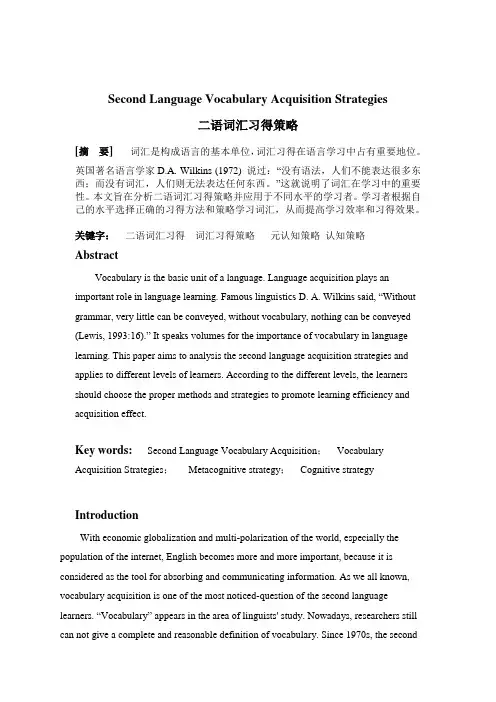
Second Language Vocabulary Acquisition Strategies二语词汇习得策略[摘要]词汇是构成语言的基本单位,词汇习得在语言学习中占有重要地位。
英国著名语言学家D.A. Wilkins (1972) 说过:“没有语法,人们不能表达很多东西;而没有词汇,人们则无法表达任何东西。
”这就说明了词汇在学习中的重要性。
本文旨在分析二语词汇习得策略并应用于不同水平的学习者。
学习者根据自己的水平选择正确的习得方法和策略学习词汇,从而提高学习效率和习得效果。
关键字:二语词汇习得词汇习得策略元认知策略认知策略AbstractVocabulary is the basic unit of a language. Language acquisition plays an important role in language learning. Famous linguistics D. A. Wilkins said, “Without grammar, very little can be conveyed, without vocabulary, nothing can be conveyed (Lewis, 1993:16).” It speaks volumes for the importance of vocabulary in language learning. This paper aims to analysis the second language acquisition strategies and applies to different levels of learners. According to the different levels, the learners should choose the proper methods and strategies to promote learning efficiency and acquisition effect.Key words:Second Language Vocabulary Acquisition;VocabularyAcquisition Strategies;Metacognitive strategy;Cognitive strategyIntroductionWith economic globalization and multi-polarization of the world, especially the population of the internet, English becomes more and more important, because it is considered as the tool for absorbing and communicating information. As we all known, vocabulary acquisition is one of the most noticed-question of the second language learners. “Vocabulary” appears in the area of linguists' study. Nowadays, researchers still can not give a complete and reasonable definition of vocabulary. Since 1970s, the secondlanguage vocabulary acquisition research has gradually become the hot point and important subject in the second language vocabulary acquisition research area. These researches aim to discuss the efficiency vocabulary memory strategies to promote the memory skills and vocabulary levels. Then how to acquire vocabulary become popular among the researchers. Wenden &Rubin (1987), O'Malley& Chamot (1990) refer to the content of vocabulary acquisition strategies; Rubin (1987) and Oxford (1990) classify the memory strategy to the direct cognitive strategies. Especially, CohenAphek (1981), Porte (1988), O'Malley (1990), Vann (90), Cohen (1990), etc made a basic searching of vocabulary acquisition. In a word, there are various opinions in how to acquire vocabulary. Firstly, it talks about the importance of vocabulary. Secondly, what does it mean to “acquire” a word? This paper mainly aims to the detail analysis of the vocabulary acquisition from three aspects:Meta-cognitive Strategy; Cognitive Strategy and Social or Affective Strategy. Especially, it highlights the effect of the context and rending to vocabulary acquisition. This paper talks about the applications of the vocabulary acquisition strategies. And it puts forward some problems and difficulties of vocabulary acquisition. This paper also discusses the influencing factors to the acquisition. It includes the mother tongue, age, language contact, logical thinking ability, identity degree, and academic motivationThe purpose of this paper is to rise the awareness of English learners that the importance of vocabulary in language learning and the vocabulary acquisition strategies can not be neglected, and each strategies is deeply rooted in its language. Through the analysis of the theory of study, the paper tries to draw the learner's attention to the strategies of the second language vocabulary acquisition and using the vocabulary in communication. In order to improve the acquisition efficiency, some strategies put into practice are introduced.The first presents the importance of vocabulary, some basic concepts of vocabulary and vocabulary learning, the second part tells what does it mean to know a word, the third part deals with the theory of vocabulary acquisition and presents the factors and differences influencing the vocabulary acquisition. The fourth part is detailed discussionof vocabulary acquisition strategies in different levels of learners. The last part is conclusion.Literature review1. The importance of vocabularyAs the first time, when we go to school and our English teacher will tell us that vocabulary is of great importance in learning English. After several years, we understand words gradually, especially when we study in high school. If we know a little about vocabulary, we may have poor English. That is because the listening, speaking, reading and writing show the necessary of learning vocabulary.Many researchers agree that lexis is at least as important as structure, because it is using wrong words and not wrong grammar that usually breaks down communication. Mistakes in lexis much more often lead to misunderstanding and may be less generously tolerated outside classroom than mistakes in syntax. (Carter, 1987).As Stephen Krashen remarked, “When students travel, they don't carry grammar books, they carry dictionaries.A significant role of vocabulary in both teaching and learning processes was firststated by Stephen Krashen in The Natural Approach (1985):“Vocabulary is basic for communication. If acquirers do not recognize the meaning of the key words used by those who address them they will be unable to participate in the conversation.”Words are basic tools in human communication; therefore they determine the main part of people's life-relationships between people and associations with the surrounding world that people live in. The larger one's vocabulary, the easier it is to express one's thoughts and feelings.In real communication, correctly and idiomatically used vocabulary can even decrease some structural inaccuracy and grammar errors. (Zhang Jiying, 2002). So learners should enrich and expand their knowledge of words as much as possible in order to communicate effectively in a foreign language.2. What does it mean to “know” a word?Knowing a word is not a simple phenomenon. In fact, it is quite complex and goes far beyond the word's meaning and pronunciation. (Zhang Jiying, 2002). Richards (1976) think knowing a word means also knowing the frequency of words and their likely collocates; being aware of the functional and situation limitations that apply; knowledge of the “syntactic behavior”; derivational forms and word class; associative and connotative knowledge; semantic value-breaking down words into minimal units as with componential analysis (see Katz&Fodor1963or Leech1974); knowing the other (possible) meaning associated. Nagy and Scott (2000) identify several dimensions that describe the complexity of what it means to know a word. First, word knowledge is incremental, which means that readers need to have many exposures to a word in different contexts before they “know”it. Second, word knowledge is multidimensional. This is because many words have multiple meanings and serve different functions in different function in different sentences, texts, and even conversations. Third, word knowledge is interrelated in that knowledge of one word connects knowledge of other words.What all of this means is that “knowing” a word is a matter of degree rather than an all-or-nothing proposition (Beck&Mckeown, 1991; Nagy&Scott, 2000). The degree of knowing a word are reflected in the precision with which we use a word, how quickly we understand a word, and how well we understand and use words in different modes and different purpose.Knowing a word also implies knowing how that word relates to other knowledge. Finally, knowing a word means being able to appreciate its connotations and subtleties. When we know a word at this level, we can use and recognize it in idioms, jokes, slang, and puns (Johnson, &Schlicting, 2004).3. Second Language Vocabulary Acquisition StrategiesVocabulary acquisition is the part of English learning. Since 1960s, more and more attentions and researches had been toward to vocabulary acquisition strategies. When it comes to 1980s or 1990s, the vocabulary acquisition strategies gain fruitful results. Cohen Aphek (1981), Porte (1988), O'Malley (1990), Vann (1990), Cohen (1990) made a basic discussion in vocabulary acquisition strategies.O'Malley&Chamot (1990) classify language learning strategy into three methods: Meta cognitive strategy, Cognitive strategy, and Social or Affective strategy. Meta cognitive strategy refers to strategies of advance preparation, directed attention, selective attention, self-management, self monitoring and self-evaluation. And the results indicate that the metacognitive strategy teaching is significant in developing learner autonomy, which shows prominent pros-pectin foreign language teaching. A cognitive strategy serves to support the learner as he or she develops internal procedures that enable him/her to perform tasks that are complex (Rosen shine, 1997). The use of cognitive strategies can increase the efficiency with which the learner approaches a learning task. These academic tasks can include, but are not limited to, remembering and applying information from course content, constructing sentences and paragraphs, editing written work, paraphrasing, and classifying information to be learned.The memory strategy, cognitive strategy, social strategy and metacognitve strategy are used more frequently than the affective strategy and compensative strategy.Oxford (1990) put forward a more comprehensive classification system of strategy, which includes six categories: memory strategy, cognitive strategy, compensatory strategy, metacognitive strategy, affective strategy, and social strategy. Nation (1990) put forward semantic manufacturing strategy of “what is it”. From different aspect, researchers have different classification of strategies. Stoffer (1995) made a factor analysis of 53vocabulary acquisition strategies and extract 9 factors: the strategy of practice and apply words in authentic situation; the strategy of creative learning vocabulary; the self-motivation strategy; the strategy of psychological connection; memory strategy; the strategy of audio/visual assisted learning; with the movement to the body of learning vocabulary strategy; the strategy of overcoming anxiety; the strategy of using to organize units.Schmitt (1997) composite the related language acquisition strategies upon classification, and put forward two categories of vocabulary acquisition strategy, namely discovery strategy and consolidation strategy.In china, acquisition strategies researcher, Wen Qiufang(1996) thought:English learning strategy includes concept and method. What is concept? It means the acquaint learners to how to learn English well. And the method refers to the actions that learners take to learn English well. The method can be classifying two categories: manage method and learning method. Wuxia, Wangqiang(1998) draw lessons of classification of learning strategies from O'Malley&Chamot's and thing that the majority of students can not depend on the mechanical memorizing to learn English vocabulary. Wenpeng (2000) utilize “the level of processing approach of memory” to do an empirical research on different words meaning.Willians and Burden (2000) stress metacognition is central to effective learning. Wenden(1987) says that metacognitive is “the process that underlines the efficient use of strategies and the essence of intelligent activity” (p573). Quicke (1994) similarly views that metacognitive awareness is crucial in learning strategies. In addition, most of the studies (O'Malley and Chamot1990, Wenden and Rudin 1987; Oxford andCrookall1989) founder the learners who were particularly taught metacognitive knowledge to help them assess the needs, evaluate process and give directions to their learning.After summarizing the theories of the vocabulary acquisition strategies, I express my opinions about vocabulary acquisition strategies. These theories or opinions have their merits and demerits. I am in favor of O'Malley& Chamot's theory of the classification of vocabulary acquisition strategies: metacognitive strategies, cognitive strategies, affective strategies. The metacognition represents strategies of acquiring knowledge, namely the ability to understand pour method for learning and assimilating information. It concerns “the knowledge of your thoughts”. In addition to how various factors influence psychological thought processing.As far as I am concerned, vocabulary really plays an essential role in language learning. For example, when we communicate with others, vocabulary is the basic component between your talking. Without words, without communication. In the school, every student should learn vocabulary, the more vocabulary you acquire, the more knowledge you will get. In the process of our study, every skill needsvocabulary. (Listening, speaking, reading, and writing). Especially, in the extensive reading, the vast majority vocabulary can be learned gradually through repeated exposures in various discourse contexts. However, not all methods are appropriate for all levels of learners. Thus, I deem that different levels of learners should choose different strategies of vocabulary acquisition strategies.When talking about second language vocabulary acquisition strategies, we may talk it from pro-school children. Chenhua, zhangyifang (2001) analysis the narrative approach of memory process of vocabulary. The study discovers the majority of Chinese children acquire vocabulary with repeat memory strategy. That is to say children memory Chinese meaning through the Chinese- English bilingual. When memorizing vocabulary, Chinese children seldom utilize the Keyword strategy and Semantic coding strategies. They do not use metacognitive strategy. In my opinion, children can be helped to acquire vocabulary in the form of games. Meanwhile, vocabulary acquisition of pro-children should be carried out in a real context. It has a long progress. According to different age, children acquire vocabulary in different strategies. For the lower class, children acquire the single word. For the middle class, the children begin to acquire the double or three words. When the children are nearly 6 six years old, they form a semantic system. The teacher can help children acquire vocabulary in the context or games.4. Cognitive strategy4.1 Using dictionary strategiesCheck the dictionary is the most common strategy of acquires vocabulary. And it also an important manner to learn English. It has been shown that students who use a bilingual dictionary learn more vocabulary than students who read without a dictionary (1993:263-287). However, when students turn to a dictionary for every word they do not understand, they lose sight of the meaning within the text as a whole. Teachers and textbook designers have realized this, and they argued that learning strategies such as guessing from context should be employed in order to read the text fluently and smoothly for an overview of the whole text. Researchers have commented that this movement may have gone too far, and today's literature impliesthat good language learners rely on dictionaries less than poor language learners and are more successful at employing contextual guessing strategies.These researchers found that dictionaries were used equally by both good and poor English achievers. There was, however, the notable difference in the way students used their dictionaries: Dictionary used by high achievers involved a series of questions: “Was it necessary to consult the dictionary? What information in the dictionary was relevant? Was the information worth copying down, and if so, in Chinese or in English?” Low achievers, on the other hand, followed” a relatively inflexible set of procedures for dictionary use rather than a decision0 making process”(wen, Q.,& Johnson, R. K., 1997:36 ).4.2 Semantic guessing strategyHuckin, Hnynes & Coady (1993) deeply study the context-based meaning. Guessing strategy plays an important role in acquiring vocabulary, cultivating their guessing words ability can improve their reading speed, and save time. So it can stir up their reading interests and enlarge their page views. Skills for guessing unfamiliar English words tell us how to guess words. Getting meaning from inference means that you infer, or guess, meaning from the clues provided by the context –the sentence or passage in which the word appears. There are four steps. First, decide what part of speech of speech the unfamiliar words. Next, make out what the sentence or passage is about. Then, find out the words or phrases that help you get the idea. Finally, use these clues to guess the meaning of the word. For an example:The soldiers were ordered to fire at the enemy.Questions:1.What part of speech is “fire”? _________.2.Does the sentence talk about war, business, or a bale? ___________.3.What words in the sentence helped you answer Question 2?_________and_________.4.Fire means__________a)to let someone from a jobb)to shootc)red-hot flamesThe sentence contains two clues to the meaning of “fire”. First, “fire”is a verb. Second, he sentence talks about war; the word “soldiers” and “enemy”help you understand this. You can immediately eliminate the choice “red-hotflames”, since it is a noun answer that refers to blame. Although the choice “to let someone go from a job” is a verb answer, it refers to business and should be eliminated. The choice “to shoot” is a verb answer that talks about fighting; it is the correct answer.4.3 Memory strategy of vocabulary acquisitionThe so-called memory strategy refers to various memorizing methods or skills for students, its principles are: tide up, organize and relate to the content. In China, memory method is a traditional strategy to learn vocabulary. In order to deal with the examinations, the students adopt the memory strategy. The common memory strategies are: keyword strategy, word list, context strategy.4.4 Keyword strategyThe key word strategy can benefit a wide variety of students with language needs in the areas of vocabulary, comprehension of academic language, sentence structure, organizing and explaining information, and transferring information across settings. When the strategy is routinely used, students can master its basic mechanics and key word review during direct language intervention sessions can be a foundation for increasingly complex and challenging practice and review of a variety of curriculum based language skills. Keyword strategy is put forward by Atkinson (1975). The method includes two steps: first, the learners find out the similar sounding word between the mother langue and the second language. Second, build up a metal image. Paivio (1991), Pressley (1982) think that keyword strategy is important. However, it has its limitation, which is difficulty to find the same pronunciation of each word. In China, Wangwenyu (1998) found that Chinese students seldom use the keyword strategy because of its complexity.4.5 Word listNation (1982) makes a conclusion: word list is an efficient way to accumulate large number of vocabularies in a short time. O' Malley &Chamot (1985) think that mechanical memorizing is the efficient way to memory vocabulary. Decontextualized word list have been used extensively to teach vocabulary. Presenting vocabulary inlist form is an efficient study method in which students can learn large numbers of words in a short time (Meara P.1995:8-10). Such list, however, having been stripped of context, are difficult to deal with. A majority of language learners prefer decontextualize word lists just because the application of such list seems to be more practical and much easier to deal with, saving more time.In addition to facilitating memorization and learning, word list serve another purpose in the reading class: motivation. Upon adopting a corpus-based list of the 3,000 most frequently used words. List is much more effective to help students focus on less-frequently encountered words that require more intensive study and organized review.4.6 Context strategyThe second language vocabulary acquisition can not be separate from context. Context is a main factor of vocabulary acquisition. It is an efficient method to acquire vocabulary in the context. From the semantics point of view, James Inhofe announce d the regularity of acquiring vocabulary in From Paragraph to Essay. The basic principle of acquiring vocabulary focus on the context, so that we can know the relation between the form and meaning. By Krashen's Monitor Hypothesis Theory, many researchers tend to acquire vocabulary in the context.5. Other strategiesResearchers study the other strategies to acquire vocabulary. Contact method, Semantic coding method, assimilation strategy, self-text strategy.When I was in the third year in the college, I have a lexical class. From the class, we know many strategies to acquire vocabulary:Repetition, suited for kids and primary school students. Spelling and pronunciation, suited for middle school students. Context, learning the new words in phrases, sentences, never learn it alone. Semantic: grouping words according to the meaning, sound, semantic field and so on. It is for all levels. Association: free association of antonyms, antonyms, homonyms, and homonyms. Emotion: learning words with strong emotions, or emotional sentences. Different physical surroundings:learning in one place is low efficiency than more places. Over learning: word cards or flashes: use key words cards.In a word, vocabulary acquisition plays an important role in English language learning. It is necessary for learners to command of vocabulary acquisition strategies. Because it can help us acquire vocabulary more efficient and communicate with people in life.ConclusionThis paper has attempted to provide some theories of second language vocabulary acquisition and some strategies. Such as metacognitive strategy, cognitive strategy, and social strategy. However, this paper also put forward some microcosmic strategy. As a matter of fact, vocabulary acquisition should combine the context. In addition, this paper hasn't mentioned that culture is also an important factor in vocabulary acquisition. In the study of second language vocabulary acquisition, we should pay attention to the process and the acquiring results. This paper focuses on the study of the second language vocabulary acquisition strategies.Bibliography[1] A.U. Chamot. The Learning Strategies of ESL Students. In A. L. Wenden & J.Rubin, (eds), Learner Strategies in Language Learning, 1987.[2] Cater. R. and M. McCarthy. Vocabulary and Language Teaching. New York:Longman, 1987.[3] Nation, L. S. P. Teaching and Learning Vocabulary. New Newbury HousePublishers, 1990.[4] O'Malley, J. & Chamot, A. U.. Learning Strategies in Second LanguageAcquisition [J]. Cambridge University Press, 1990:12-15.[5] Oxford, R.. Language Learning Strategies [M]. Newbury House, 1990.[6] Paivio, A. Vanadian Journal of Psychology, 1991(45).[7] Pressley, M& Levin, J. R& Delaney, H. D. Review of Educational Research,1982(52).[8] Rudin, J.. Learners strategies: theoretical assumptions, research history andtypology [A]. In A. Wenden, J. Rubin (eds). Learning Strategies in Language Learning [C]. New York: Prentice Hall. 1987.[9] Schmitt, N. & McMarthy, M. (Eds). Vocabulary: Decription Acquisition andPedagogy. Cambridge: Cambridge University Press, 1997.[10] 陈桦,张益芳.中国儿童英语词汇记忆策略探究[J].外语学刊,2001(4).[11] 戴曼纯. 论第二语言词汇习得研究[J]. 外语教学与研究,2002(2).[12] 徐德凯.大学英语词汇教学理论与实践[M].长春:吉林出版集团有限责任公司,2009.[12] 王文宇.观念、策略与英语词汇记忆[J].外语教学与研究,1998(1).[13] 文秋芳. 英语学习策略论.上海:上海外语教育出版社,1996.[14] 吴霞,王蔷.非英语专业本科生词汇水平研究. 外语教学与研究,1998(1).[15] 张纪英.英语词汇学教学与研究[M]. 武汉:华中科技大学出版社,2007.[16] 朱厚敏. 英语词汇学习策略研究[M] 长春:吉林大学出版社,2009.。
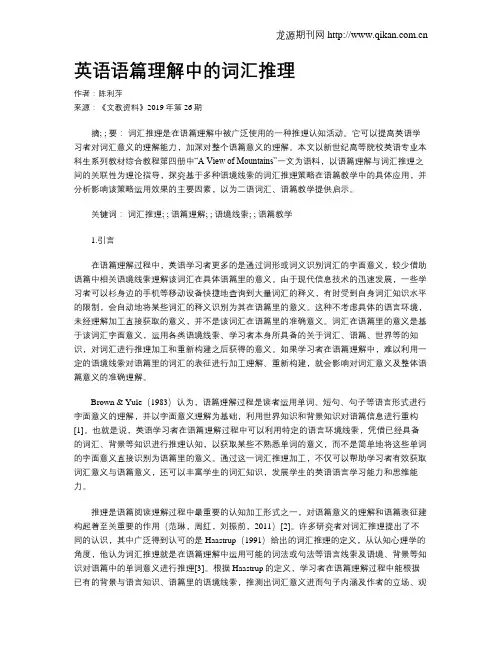
英语语篇理解中的词汇推理作者:陈利萍来源:《文教资料》2019年第26期摘; ; 要:词汇推理是在语篇理解中被广泛使用的一种推理认知活动。
它可以提高英语学习者对词汇意义的理解能力,加深对整个语篇意义的理解。
本文以新世纪高等院校英语专业本科生系列教材综合教程第四册中“A View of Mountains”一文为语料,以语篇理解与词汇推理之间的关联性为理论指导,探究基于多种语境线索的词汇推理策略在语篇教学中的具体应用,并分析影响该策略运用效果的主要因素,以为二语词汇、语篇教学提供启示。
关键词:词汇推理; ; 语篇理解; ; 语境线索; ; 语篇教学1.引言在语篇理解过程中,英语学习者更多的是通过词形或词义识别词汇的字面意义,较少借助语篇中相关语境线索理解该词汇在具体语篇里的意义。
由于现代信息技术的迅速发展,一些学习者可以杉身边的手机等移动设备快捷地查询到大量词汇的释义,有时受到自身词汇知识水平的限制,会自动地将某些词汇的释义识别为其在语篇里的意义。
这种不考虑具体的语言环境,未经理解加工直接获取的意义,并不是该词汇在语篇里的准确意义。
词汇在语篇里的意义是基于该词汇字面意义,运用各类语境线索、学习者本身所具备的关于词汇、语篇、世界等的知识,对词汇进行推理加工和重新构建之后获得的意义。
如果学习者在语篇理解中,难以利用一定的语境线索对语篇里的词汇的表征进行加工理解、重新构建,就会影响对词汇意义及整体语篇意义的准确理解。
Brown & Yule(1983)认为,语篇理解过程是读者运用单词、短句、句子等语言形式进行字面意义的理解,并以字面意义理解为基础,利用世界知识和背景知识对语篇信息进行重构[1]。
也就是说,英语学习者在语篇理解过程中可以利用特定的语言环境线索,凭借已经具备的词汇、背景等知识进行推理认知,以获取某些不熟悉单词的意义,而不是简单地将这些单词的字面意义直接识别为语篇里的意义。
通过这一词汇推理加工,不仅可以帮助学习者有效获取词汇意义与语篇意义,还可以丰富学生的词汇知识,发展学生的英语语言学习能力和思维能力。
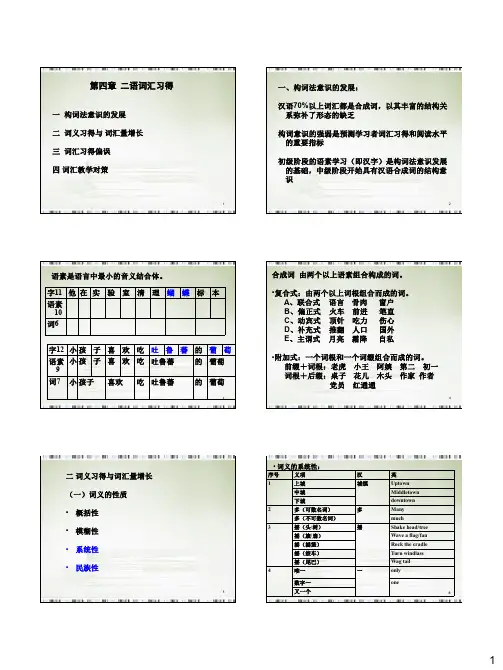
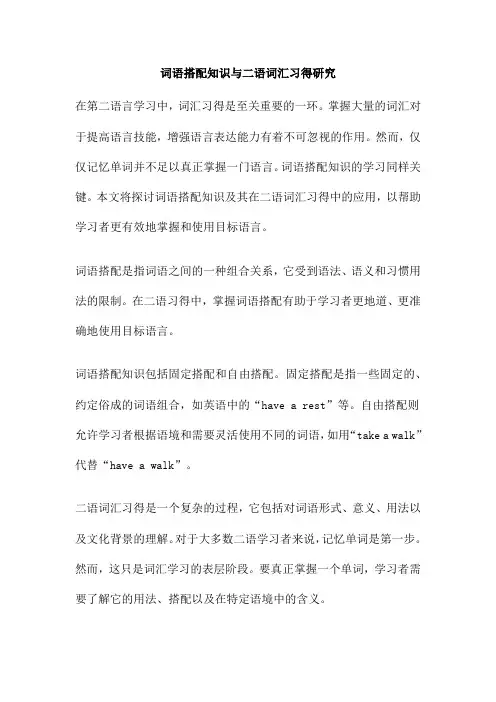
词语搭配知识与二语词汇习得研究在第二语言学习中,词汇习得是至关重要的一环。
掌握大量的词汇对于提高语言技能,增强语言表达能力有着不可忽视的作用。
然而,仅仅记忆单词并不足以真正掌握一门语言。
词语搭配知识的学习同样关键。
本文将探讨词语搭配知识及其在二语词汇习得中的应用,以帮助学习者更有效地掌握和使用目标语言。
词语搭配是指词语之间的一种组合关系,它受到语法、语义和习惯用法的限制。
在二语习得中,掌握词语搭配有助于学习者更地道、更准确地使用目标语言。
词语搭配知识包括固定搭配和自由搭配。
固定搭配是指一些固定的、约定俗成的词语组合,如英语中的“have a rest”等。
自由搭配则允许学习者根据语境和需要灵活使用不同的词语,如用“take a walk”代替“have a walk”。
二语词汇习得是一个复杂的过程,它包括对词语形式、意义、用法以及文化背景的理解。
对于大多数二语学习者来说,记忆单词是第一步。
然而,这只是词汇学习的表层阶段。
要真正掌握一个单词,学习者需要了解它的用法、搭配以及在特定语境中的含义。
二语词汇习得途径多样。
学习者可以通过阅读、听力、口语交流等多重渠道扩展词汇量。
使用语言学习软件、参加语言课程等也是有效的学习方法。
在学习过程中,将词语搭配知识和二语词汇习得方法结合起来应用,可以帮助学习者提高写作能力。
以下是一些具体实践方法:建立词语搭配词典:学习者可以整理学习过程中遇到的词语搭配,形成自己的搭配词典。
这样可以在写作时快速查找并运用合适的搭配。
观摩地道语料:通过观看影视作品、阅读文学作品等,学习者可以观察和分析目标语言的地道表达方式,从而习得新的词语搭配。
翻译练习:翻译是一种有效的语言学习方法,通过将目标语言与母语进行对比,学习者可以深入理解词语的语义和用法,并在写作中运用所学的搭配知识。
创造语境:学习者可以模拟目标语言的使用环境,通过与他人交流、写日记等方式,创造更多的语言实践机会,从而巩固和拓展词汇量及词语搭配知识。
论二语词汇深度及发展特征关于词义与词缀实证调查一、概述随着全球化的进程不断加速,第二语言(二语)的学习已成为现代社会不可或缺的一部分。
对于二语词汇的深度理解及其发展特征的探究,对于语言教学、语言习得以及语言应用等多个领域都具有十分重要的意义。
本文旨在探讨二语词汇深度及发展特征,特别是词义与词缀的实证调查。
词汇深度是反映语言学习者水平的一个重要指标,它涉及到词汇知识的广度和深度,包括词汇的认知、理解、使用以及其在不同语境中的应用。
而二语词汇的发展特征,则体现在语言学习者在习得过程中,词汇知识的积累、转化以及习得规律等方面。
本文将对词义与词缀的关系进行深入探讨,分析二者在二语学习过程中的相互作用和影响。
本文将通过实证调查的方式,分析二语学习者的词汇深度及其发展特征。
实证调查是语言学研究的重要方法之一,通过收集实际数据,能够更准确地揭示二语词汇习得的规律,为语言教学和语言学习提供有价值的参考。
1. 引入研究背景:二语词汇深度与词义、词缀的关系。
随着全球化的加速和跨文化交流的日益频繁,第二语言(二语)学习已成为许多人生活和学习的重要组成部分。
在二语学习中,词汇学习是至关重要的一环。
即学习者对词汇的掌握程度,对于理解文本、进行交流以及使用二语进行思维有着不可或缺的影响。
词汇的深度往往与词汇的词义和词缀密切相关。
即词语的意义,是词汇学习的基础。
对词义的准确理解和使用,直接影响到二语学习者的阅读和写作能力。
词义的理解和运用是二语学习者从初级到高级的重要转折点,探索词义与词汇深度之间的关系,对于二语词汇教学具有重大的实践指导意义。
作为构成词汇的重要部分,其理解和学习同样对二语词汇深度有重要影响。
如前缀、后缀,可以改变词的基本意义,为词赋予新的含义或属性。
掌握词缀的学习者往往能更快速、准确地掌握新词汇,扩大词汇量。
研究词缀与词汇深度之间的关系,对于提高二语学习者的词汇学习效率具有重要意义。
二语词汇深度与词义、词缀之间存在着复杂的相互关系。
中介语:L2学习者内化了心理语法,一个自然的语言系统可以用语言规则来描述。
目前的生成语言学关注中介语的表征,这一焦点可以视为原始的中介语假说的衍生。
中介语能力的本质,中介语语法多大程度上类似于其他语法以及UG的作用,都有一些明确的论述。
一直在争论的问题:UG是否对L2有调节作用,程度多大。
这个问题源于1.语言的普遍性的个别观点和2.关于语言能力本质的个别假说。
生成语法的传统观点,语法是心理表征,普遍规限制这些表征。
语言的普遍性的存在源于人类思想的属性,语法的存在源于他们的普遍规则。
UG在L2习得中的作用,前十年,主要关注“Access”:探索UG在非一语习得中是否仍然有效,这一问题关系到一些基本的问题:什么是自然的语言语法?语言能力的本质是什么,又是如何习得?UG的解释是一个局部的答案,至少在一语语法习得中是这样。
没有具体的天生的语言规则来限制语法,不可能习得语言?在L2习得研究中,问题是:中介语表征是否受UG的限制。
2. UG和语言习得的逻辑问题逻辑问题的由来:柏拉图本人认为,人类就是凭借天赋神授的理性,才得以获得广博无限的知识。
“柏拉图问题”同样表现在儿童语言能力的获得上。
对这一问题研究数十年的乔姆斯基,到最近还发出这样的惊叹: “儿童知道的远比经验提供的多……在语言生长的高峰时间,虽然儿童的语言接触非常有限,语言环境又模棱两可,但儿童大约每小时就可以学会一个词。
儿童理解词汇方式之精巧奇妙,非任何词典能及……语言习得更像是一般器官的生长;它是发生在儿童身上的事,并非儿童所做的事。
”(Chomsky , 2000 :6 - 7)语言学家们把这一表现在儿童语言知识获得过程中的“柏拉图问题”称之为语言习得中的“逻辑问题”。
简单地说, 逻辑问题基于所谓的“刺激贫乏说”,旨在解决儿童语言有限、残缺、不足的语料输入及最终能在短短几年里迅速而一致地获得丰富的语言系统这一貌似不合逻辑的问题。
无论是经验主义哲学的感觉经验,还是行为主义的刺激反应、重复模仿的“逻辑”都无法给予圆满的解释。
基金项目:本文为2013年山东省高等学校人文社会科学研究项目“二语习得中的词汇推理研究”的研究成果之一(项目编号为J13WD21),项目主持人:李业霞。
作者简介:宋菲(1989—),山东邹平人,聊城大学大学外语教育学院2013级研究生,研究方向为学科教学(英语);李业霞(1969—),山东新泰人,聊城大学大学外语教育学院副教授,硕士生导师,研究方向为英语教学与二语习得研究。
摘要随着二语词汇习得研究的深入,词汇在语言习得中的作用越来越受到人们的重视,尤其在阅读中。
因此要提高学生的阅读效率,就必须教会学生运用一定的词汇推理策略,从而克服词汇障碍,提高阅读效果和速度。
关键词词汇语篇阅读词汇推理The Study of Vocabulary Reasoning in High School Eng 原lish Reading //Song Fei,Li Yexia Abstract With the study of Second Language Vocabulary Ac-quisition going deeper and deeper,the importance of the vocabu-lary in language acquisition is catching more and more people's attention,especially in reading.So if we want to improve stu-dents'reading efficiency,it is necessary to teach students to use vocabulary reasoning strategies to overcome the obstacles of vo-cabulary.By doing this it can improve the reading efficiency and speed.Key words vocabulary;passage reading;vocabulary reasoning 1引言在语篇阅读过程中,推理具有非常重要的作用。
词语解释教学策略和资源选择在语言学习和教学过程中,词语解释是一项重要的教学任务。
教师需要通过有效的教学策略和恰当的资源选择,帮助学生理解和运用新词语。
本文将探讨词语解释教学策略和资源选择的原则和方法。
一、教学策略1. 上下文法上下文法是一种常用的教学策略,通过将新词语嵌入到语境中来帮助学生理解其含义。
教师可以选择一段与课文相关的文章或对话,引导学生通过上下文理解新词语的意义。
例如,教师可以提供一段描述自然景观的文章,引导学生根据上下文来推测陌生词语,如"雄浑"、"瑰丽"等。
2. 词形分析法词形分析法是一种通过分析词根、前缀和后缀来推测词义的方法。
教师可以引导学生根据词根和词缀的意义,猜测词语的含义。
例如,当遇到生物学词汇时,通过分析词根和词缀,学生可以推测出相关词语的含义,如"生物"、"生态"等。
3. 比喻和联想法比喻和联想法是一种通过将新词语与学生已有的知识和经验联系起来来帮助学生理解词义的方法。
教师可以引导学生通过比较和类比的方式来理解新词语的意义。
例如,当学生遇到抽象的形容词时,教师可以通过比喻和联想的方式,将其与学生熟悉的事物进行类比,加深学生对词义的理解。
二、资源选择1. 词典词典是一种常用的资源选择,可以帮助学生查找和理解词语的含义。
教师可以向学生介绍不同类型的词典,如学生词典、双语词典和专业词典,并教授如何使用词典查询词语的含义、词性和用法。
2. 多媒体资料多媒体资料,如图表、图片和视频,可以提供丰富的视觉信息,帮助学生理解和记忆新词语。
教师可以选择与课文相关的多媒体资料,引导学生通过观看和分析图表、图片和视频来理解新词语。
同时,教师还可以邀请学生使用多媒体工具,如在线词典和词义搜索引擎,扩展他们的词汇知识。
3. 语料库语料库是一种收集和整理真实语言材料的资源,可以帮助学生了解词语的真实用法。
教师可以引导学生使用语料库查询词汇的用法、搭配和变形,并通过分析真实的语言材料,提升学生对词语的理解和运用能力。
高中2年级英文单词备考技巧与策略在高中二年级的英文学习中,词汇备考往往是决定语言能力的关键一步。
想象一下,词汇就像是你语言的砖石,每一个单词都是构建理解和表达的基础。
掌握这些单词不仅能提升你的阅读理解能力,还能增强写作和口语表达的精准度。
以下是一些技巧与策略,帮助你在备考过程中事半功倍。
首先,建立一个词汇表格就像是为你的学习打下坚实的基础。
每天挑选一定数量的单词,将它们记录在表格中,包含词性、定义、例句以及词汇的同义词和反义词。
这样做不仅有助于记忆,也方便随时复习。
将单词分门别类地整理,使得学习不再杂乱无章,更具针对性。
其次,运用联想记忆法来帮助记忆单词。
例如,将新单词与熟悉的事物或形象联系起来,这样能够加深对单词的记忆。
假如你正在学习“resilient”(有弹性的),可以想象一根弹性十足的橡皮筋,这种联想能让你在脑海中形成清晰的单词图像,帮助记忆。
同时,使用单词卡片进行记忆是一种有效的技巧。
每张卡片的一面写单词,另一面写定义和例句。
你可以随身携带这些卡片,在空闲时间随时抽查自己的记忆情况。
此外,利用应用程序创建数字化单词卡片,也可以使学习过程更具互动性和趣味性。
实践是巩固记忆的关键。
将新学的单词应用于实际语境中,如写作文或进行口语练习,可以帮助加深记忆。
例如,在写作中主动使用新词汇,不仅能提高文章质量,还能使你对这些词汇的运用更加熟练。
参与英语讨论或模拟对话练习,也能让你更自然地运用这些单词。
定期复习是保持词汇记忆的必要环节。
设定复习计划,按照一定的时间间隔回顾已学的词汇。
可以使用艾宾浩斯遗忘曲线理论,将复习时间安排在适当的间隔,以提高记忆的持久性。
每次复习时,尝试用不同的方式,如写作、朗读或口头测试,来检验自己的记忆效果。
除了传统的记忆方法,阅读和听力训练也不可忽视。
通过阅读英文文章或听英语广播,你可以在真实的语言环境中遇到并复习新词汇。
这种方式不仅能帮助你了解词汇的实际用法,还能提高你对单词的敏感度。
二语词汇知识对词汇推理及其策略选择引言
推理是阅读过程最重要的认知加工形式之一。
词汇推理是读者根据一切可得的语言线索,结合学习者对于世界的常识、语篇的理解以及其自身的语言知识推测单词意义的一种认知策略。
因此,词汇推理策略需要植入到教学中来。
但是词汇知识对于词汇推理成绩的预测力度以及对于词汇推理策略选择的影响等问题我们尚不知道。
为此,本研究运用SPSS对搜集的数据进行定量分析,考察了词汇知识对于词汇推理成绩和词汇推理策略选择的重要性。
研究方法
(一)研究对象
本研究的对象为大三英语专业一个班42名学生。
(二)研究工具
研究工具为一份词汇量测量,采用Nation于1983年和1990年设计的词汇等级测试卷(Vocabulary Levels Test)。
共有50组词汇,每组包括6个备选词和3个定义。
受试每选对一个定义得一分,测试总分为150 分(3×50) 。
一份词汇深度知识测量表,词汇深度测试主要测试了词汇知识中的词义和搭配,分为两部分。
第一部分是Read 于1998 年的WordAssociation Format (WAF)。
此量表分为两栏,左栏为目的词的同义词,右栏为该词的搭配。
第二部分为Benson (1985)曾认为词汇的搭配应包括两类,即形容词名词的搭配和动词名词的搭配。
一篇阅读文章,该文选自Nassaji(2003)的研究,主要为批评发达国家在对落后国家实施健康援助计划中的错误做法。
对这篇阅读文章中的10个目标词进行推理。
推理成绩评判采用三级标准。
语义和语境都正确的猜测为成功猜测,得2分;语义不正确但语境可以接受的猜测为部分成功,得1分
(三)研究变量
本研究主要探讨二语词汇广度知识与深度知识与词汇推理及其策略的影响。
自变量为二语词汇广度知识与二语词汇深度知识,因变量为词汇推理成绩及其策略。
(四)数据分析
将所有数据进入SPSS19.0进行分析,采用的统计方法有相关分析和一元线性回归和描述统计方法。
结论与启示
二语词汇广度知识对于词汇推理成绩的影响大于二语词汇深度知识对于词汇推理成绩的影响。
词汇量较高的受试者倾向于借助大的语境来进行词汇推理,而词汇量较小的受试者则往往借助构词法、词汇搭配、连接词等小的方面进行词汇推理。
结果表明,学习者在词汇知识学习中的首要任务就是要加大词汇量。
本研究的受试者较少,如果受试者增多,研究结果是否会变化;二语词汇深度是否会影响词汇推理策略类型的选择等问题还需在以后的研究中进一步深入探讨。